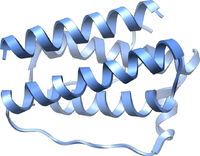
The effector cells and cellular mediators of immune system involved in cardiac inflammation and fibrosis after myocardial infarction
Sign Up to like & getrecommendations! Published in 2020 at "Journal of Cellular Physiology"
DOI: 10.1002/jcp.29732
Abstract: The cardiac repair after myocardial infarction (MI) involves two phases, namely, inflammatory response and proliferative response. The former is an inflammatory reaction, evoked by different kinds of pro‐inflammatory leukocytes and molecules stimulated by myocardial necrosis,… read more here.
Keywords: inflammation fibrosis; fibrosis; myocardial infarction; inflammation ... See more keywords

Sema3A promotes the resolution of cardiac inflammation after myocardial infarction
Sign Up to like & getrecommendations! Published in 2017 at "Basic Research in Cardiology"
DOI: 10.1007/s00395-017-0630-5
Abstract: Optimal healing after myocardial infarction requires not only the induction of inflammation, but also its timely resolution. In patients, 30 days post myocardial infarction, circulating monocytes have increased expression of Semaphorin3A (Sema3A) as compared to directly… read more here.
Keywords: resolution; myocardial infarction; inflammation; sema3a ... See more keywords

Lisofylline mitigates cardiac inflammation in a mouse model of obesity through improving insulin secretion and activating cardiac AMPK signaling pathway.
Sign Up to like & getrecommendations! Published in 2020 at "Cytokine"
DOI: 10.1016/j.cyto.2020.155398
Abstract: Obesity has emerged as a leading cause of death in the last few decades, mainly due to associated cardiovascular diseases. Obesity, inflammation, and insulin resistance are strongly interlinked. Lisofylline (LSF), an anti-inflammatory agent, demonstrated protection… read more here.
Keywords: inflammation; cardiac ampk; obesity induced; cardiac inflammation ... See more keywords

Reg3β is associated with cardiac inflammation and provides prognostic information in patients with acute coronary syndrome.
Sign Up to like & getrecommendations! Published in 2018 at "International journal of cardiology"
DOI: 10.1016/j.ijcard.2018.01.043
Abstract: BACKGROUND Regenerating islet-derived protein 3 beta (Reg3β) is a cardiomyocyte-derived chemokine for macrophages that is upregulated after myocardial infarction (MI) in mice. Here, we hypothesized that monitoring Reg3β expression might provide specific information on the… read more here.
Keywords: patients acute; acute coronary; reg3; cardiac inflammation ... See more keywords

microRNA-135a-5p regulates NOD-like receptor family pyrin domain containing 3 inflammasome-mediated hypertensive cardiac inflammation and fibrosis via thioredoxin-interacting protein
Sign Up to like & getrecommendations! Published in 2022 at "Bioengineered"
DOI: 10.1080/21655979.2021.2024956
Abstract: ABSTRACT Hypertension is a severe public health problem that induces cardiac injury with alterations of gene expressions. The current study sought to evaluate the mechanism of microRNA(miR)-135a-5p in NOD-like receptor family pyrin domain containing 3… read more here.
Keywords: mir 135a; cardiac inflammation; inflammation fibrosis; fibrosis ... See more keywords

FOXO3A acts as immune response modulator in human virus-negative inflammatory cardiomyopathy
Sign Up to like & getrecommendations! Published in 2023 at "Heart"
DOI: 10.1136/heartjnl-2022-321732
Abstract: Objective Inflammatory cardiomyopathy is characterised by inflammatory infiltrates leading to cardiac injury, left ventricular (LV) dilatation and reduced LV ejection fraction (LVEF). Several viral pathogens and autoimmune phenomena may cause cardiac inflammation. The effects of… read more here.
Keywords: virus negative; snp; inflammatory cardiomyopathy; cardiac inflammation ... See more keywords

Abstract 457: Outer Membrane Vesicle From Pseudomonas Aeruginosa Causes Inflammation and Cardiac Dysfunction
Sign Up to like & getrecommendations! Published in 2020 at "Circulation Research"
DOI: 10.1161/res.127.suppl_1.457
Abstract: Rationale: P. aeruginosa ( P.a ) infection causes severe pneumonia in ICU patients that lead to cardiac inflammation, eventual tissue remodeling, fibrosis, and cardiac complication. Growing evidence indicates that cardiac resident CCR2 - , MHC-II… read more here.
Keywords: cardiac inflammation; dysfunction; infection; inflammation ... See more keywords

Electroacupuncture pre-treatment alleviates sepsis-induced cardiac inflammation and dysfunction by inhibiting the calpain-2/STAT3 pathway
Sign Up to like & getrecommendations! Published in 2022 at "Frontiers in Physiology"
DOI: 10.3389/fphys.2022.961909
Abstract: Electroacupuncture (EA) has both anti-inflammatory and cardio-protective effects. Activation of calpain pathway is involved in several myocardiopathy. In sepsis, the role of calpain-2-regulated STAT3 in cardio-protective mechanism of electroacupuncture remains unclear. In this study, we… read more here.
Keywords: sepsis; cardiac inflammation; electroacupuncture; calpain stat3 ... See more keywords

Exercise Training Attenuates Acute β-Adrenergic Receptor Activation-Induced Cardiac Inflammation via the Activation of AMP-Activated Protein Kinase
Sign Up to like & getrecommendations! Published in 2023 at "International Journal of Molecular Sciences"
DOI: 10.3390/ijms24119263
Abstract: Exercise has proven cardiac benefits, but the underlying mechanisms of exercise that protect the heart from acute sympathetic stress injuries remain unknown. In this study, adult C57BL/6J mice and their AMP-activated protein kinase α2 knockout… read more here.
Keywords: exercise training; induced cardiac; activation; cardiac inflammation ... See more keywords